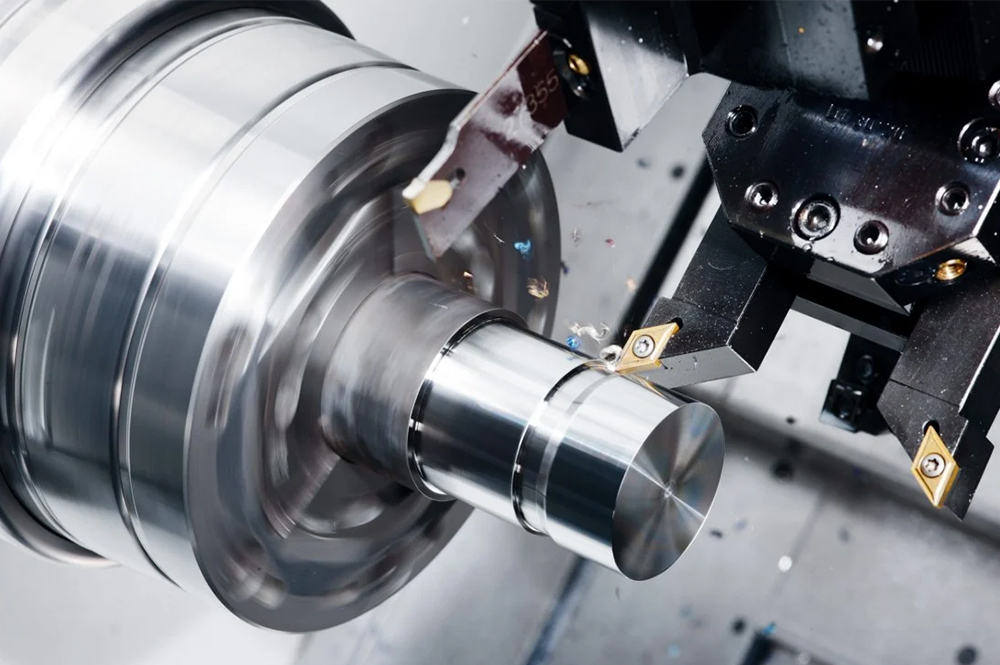What Is A CNC Machine, Types of CNC Machines
A CNC (Computer Numerical Control) machine is a sophisticated manufacturing tool that uses computer-controlled instructions to precisely shape and cut raw materials into complex designs. CNC machining ensures accuracy and efficiency in production processes.
This blog will cover CNC machines, the inner workings of CNC machines, different types of CNC, and different applications of CNC machines in various industries.
What is a CNC Machine?
Computer Numerical Control (CNC), a defining aspect of modern manufacturing, enables precise control over machinery operations. Pre-programmed software dictates the movements of tools with unparalleled accuracy and efficiency.
The movement of tools in CNC machines is orchestrated by intricate algorithms that ensure exact positioning and cutting sequences. This precision guarantees the creation of complex designs with minimal margin for error. The integration of precision and automation within CNC machines streamlines production processes, enhancing productivity and quality standards.
In the realm of CNC machining, the synergy between technology and craftsmanship is evident. The marriage of human expertise with automated precision results in the seamless execution of intricate designs. As CNC machines continue to evolve, their impact on various industries becomes increasingly profound.
How CNC Machines Work
Understanding the inner workings of CNC machines reveals their sophistication. At the core of a CNC machine lies a computer that controls the machinery through pre-programmed commands. These commands are translated into precise movements, dictating the path and speed of the cutting tools.
Key Components
- Controller: The brain of the CNC machine, interpreting the design into commands that guide the machine’s actions.
- Motors: Drive the movement of tools along the X, Y, and Z axes, enabling multi-dimensional machining.
- Feedback System: Ensures accuracy by continuously monitoring and adjusting tool positions to match the programmed instructions.
Process Overview
- Design Creation: Using CAD software, designers create a detailed model of the final product. This digital model serves as the blueprint for the machining process.
- Programming: The CAD model is converted into a series of instructions using CAM software. These instructions, often in G-code, dictate the tool paths, speeds, and cutting sequences.
- Machining: The CNC machine follows these instructions to cut, drill, or mill the material with high precision. The Controller directs the Motors and Feedback System to ensure the exact execution of the programmed movements, resulting in the accurate creation of complex designs.
Types of CNC Machines
Let’s dive into the primary types of CNC machines and their unique functions.
Milling Machines
Milling machines, a cornerstone of CNC technology, shape raw materials into precise components. These machines utilize rotating cutting tools to remove material from the workpiece, crafting intricate designs with utmost accuracy. Their versatility allows for various operations, including drilling and slot cutting, making them indispensable in manufacturing processes.
Lathes
Lathes machine cylindrical or conical shapes with ultra-high precision by holding the material in place while the tool moves along its axis. Different cutting techniques, such as face cutting and thread cutting, can be achieved using different types of lathe tool bits to meet a wide range of production needs. Understanding the various types of lathe tools and types of lathe tools used on these machines helps to achieve the best results.
CNC Routers
CNC routers, known for their versatility in woodworking and metalworking industries, carve intricate designs with finesse. These machines operate on multiple axes simultaneously, allowing for complex cuts and engravings on various materials.
Other Types
Plasma Cutters
Plasma cutters, renowned for their precision and speed, utilize a high-velocity jet of ionized gas to cut through various conductive materials. These machines excel in producing intricate shapes with clean edges, making them ideal for metal fabrication and industrial applications. The versatility of plasma cutters allows for efficient cutting of thick materials that traditional tools may struggle to penetrate. By harnessing the power of plasma technology, manufacturers can achieve high-quality cuts while maintaining productivity levels.
Laser Cutters
Laser cutters, synonymous with precision and accuracy, employ a concentrated beam of light to slice through materials with exceptional finesse. These machines are prized for their ability to create detailed designs on a multitude of surfaces, ranging from metal to wood. Laser cutters offer unparalleled control over cutting depths and patterns, enabling artisans to realize intricate creations with ease. The efficiency and versatility of laser technology have revolutionized industries such as prototyping, signage production, and custom manufacturing.
CNC Machine Applications
CNC machines are incredibly versatile, impacting various industries in numerous ways. Let’s explore five key areas where CNC machines are making significant contributions:
Automotive Manufacturing
CNC machines revolutionize automotive manufacturing by enabling the precise fabrication of critical components. From engine parts to intricate chassis elements, these machines ensure that every part meets exact specifications.
- Engine Components: CNC machines produce high-precision parts like cylinder heads and engine blocks, ensuring optimal performance.
- Chassis Elements: They create complex chassis parts that enhance vehicle durability and safety.
- Customization: CNC technology allows custom automotive parts, to cater to specific design and performance needs.
Aerospace Engineering
In aerospace engineering, the demand for lightweight yet robust components is paramount. CNC machines excel in this area, producing parts with exceptional accuracy and reliability.
- Aircraft Components: CNC machines manufacture critical parts such as turbine blades and wing ribs, essential for aircraft performance.
- Complex Geometries: They handle intricate geometries and tight tolerances required for aerospace applications.
- Material Efficiency: CNC technology maximizes material use, reducing waste and costs.
Medical Devices
The medical device industry benefits immensely from CNC machining, which creates precise and customized implants and instruments.
- Orthopedic Implants: CNC machines produce implants like knee and hip replacements, ensuring they fit perfectly and function correctly.
- Surgical Instruments: They craft delicate surgical tools with high precision, enhancing the quality of medical procedures.
- Customization: CNC technology allows for patient-specific devices, improving treatment outcomes.
Electronics and Technology
CNC machines play a crucial role in the electronics and technology sector, producing components that are essential for various devices and systems.
- Circuit Boards: CNC machines can precisely drill and mill circuit boards, ensuring reliable connections and functionality.
- Enclosures and Housings: They create durable and precise enclosures for electronic devices, protecting sensitive components.
- Prototyping: CNC technology allows for rapid prototyping of new electronic products, accelerating the development process.
Furniture and Woodworking
CNC machines have transformed the furniture and woodworking industries by enabling the creation of intricate designs and custom pieces with ease.
- Custom Furniture: CNC routers can produce detailed and personalized furniture designs, meeting specific customer needs.
- Carving and Engraving: They excel in detailed carving and engraving, adding decorative elements to wood products.
- Efficiency: CNC machines improve production efficiency, allowing for high-quality output in less time.
Conclusion
CNC machines transform raw materials into complex designs with precision and efficiency. Key components include the Controller, Motors, and Feedback System. Applications span the automotive, aerospace, and medical industries, producing critical parts like engine components, aircraft parts, and medical implants. CNC machines revolutionize manufacturing, blending technology and craftsmanship for unparalleled accuracy and customization.
Keep an eye for more news & updates on Nextweblog.com/!






